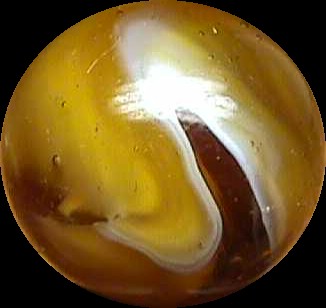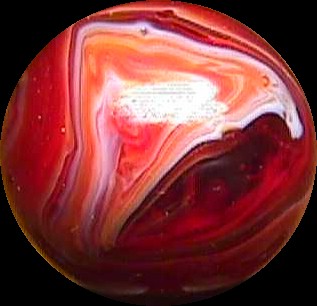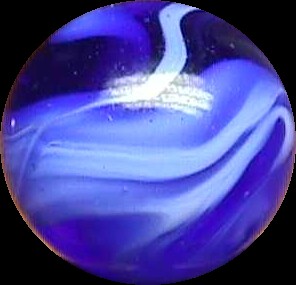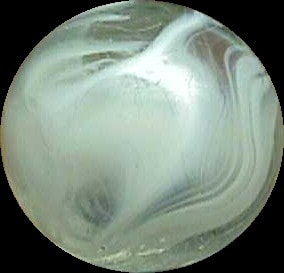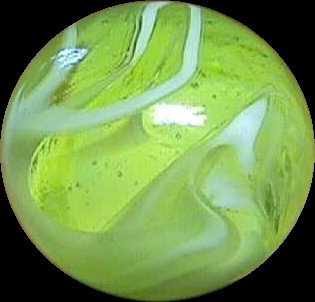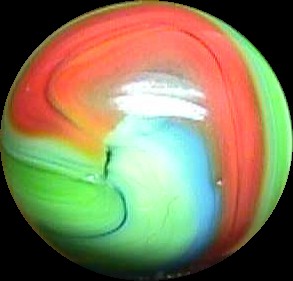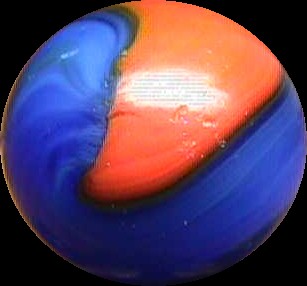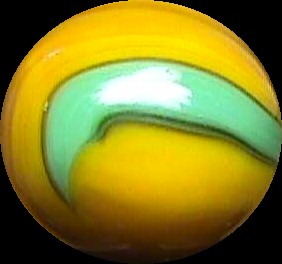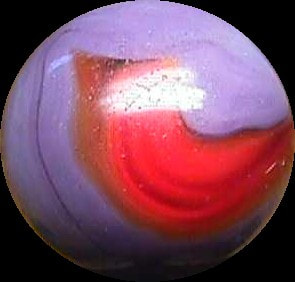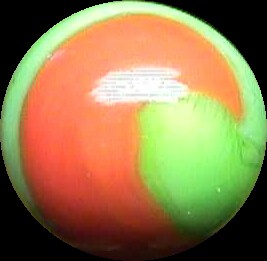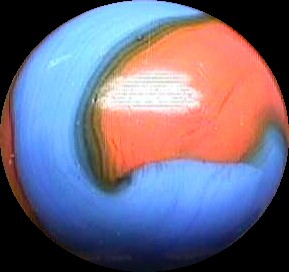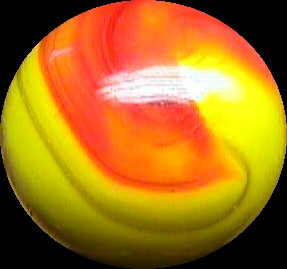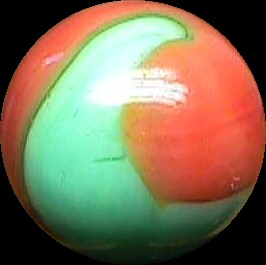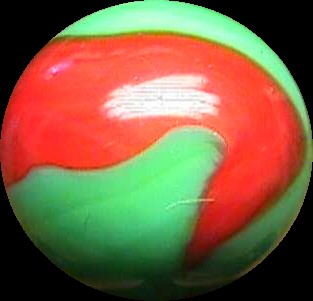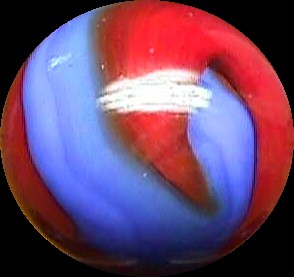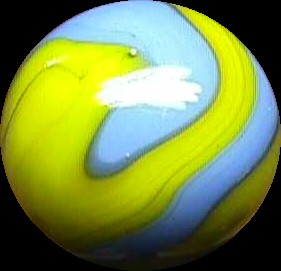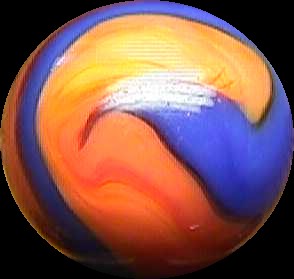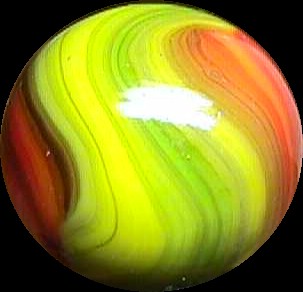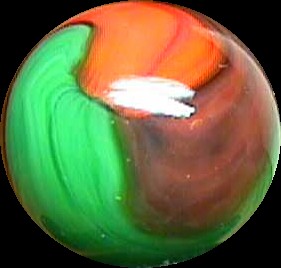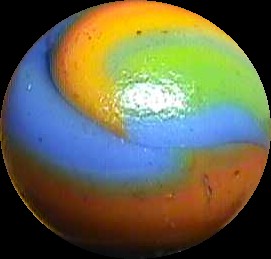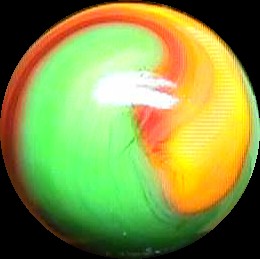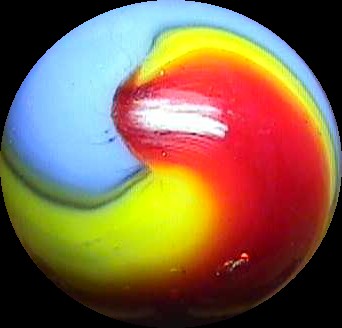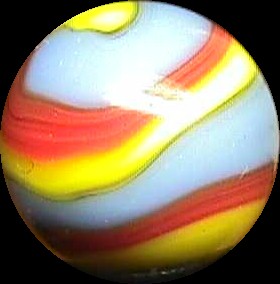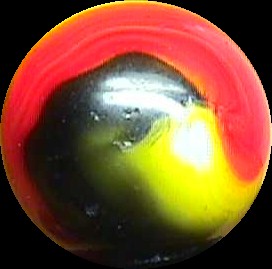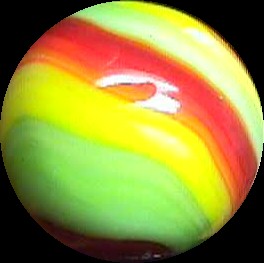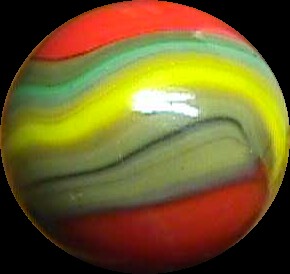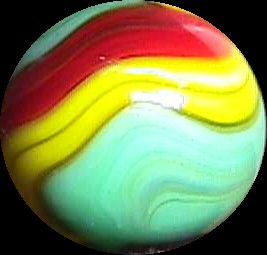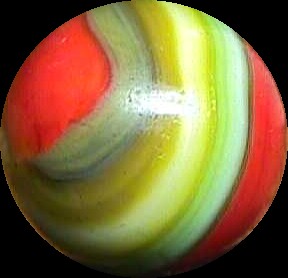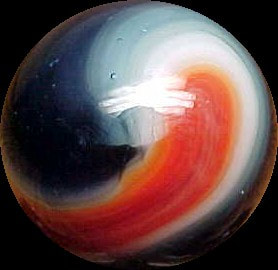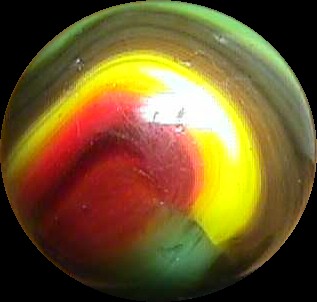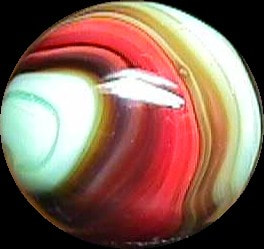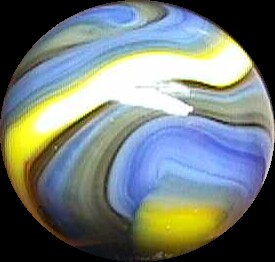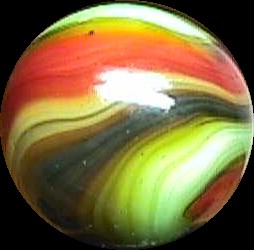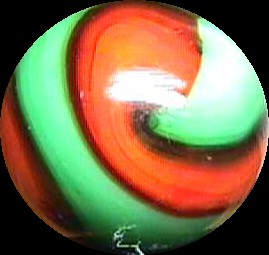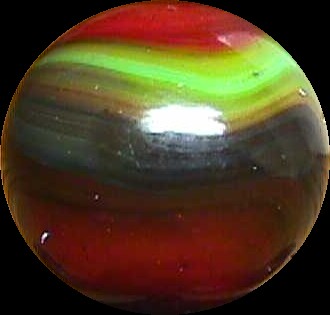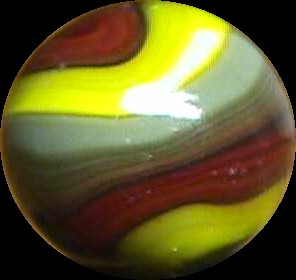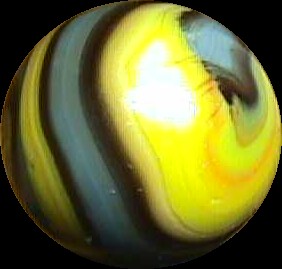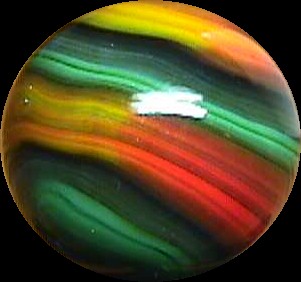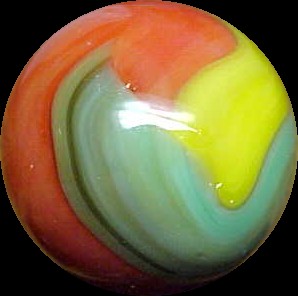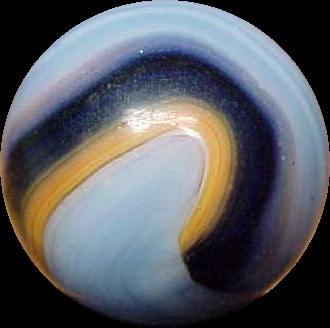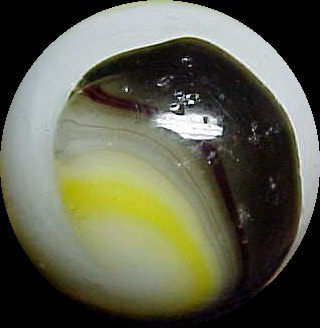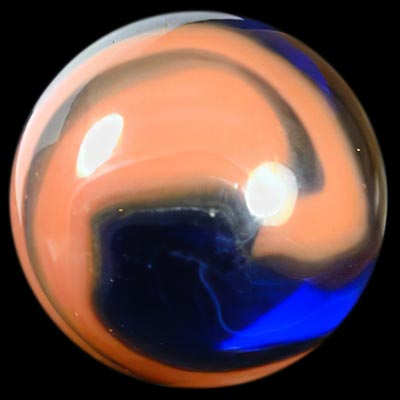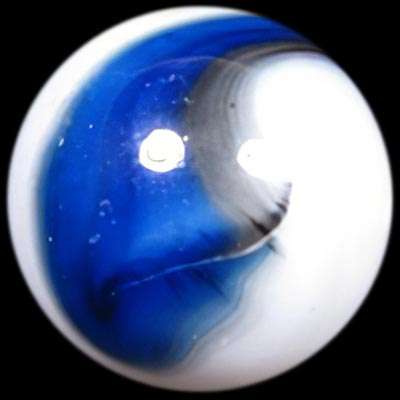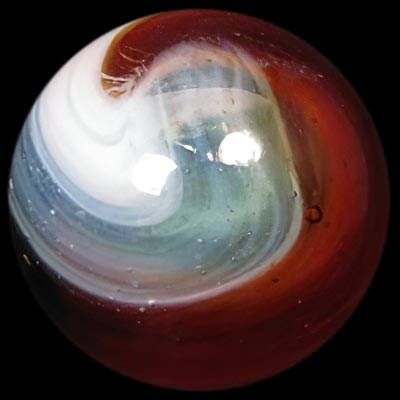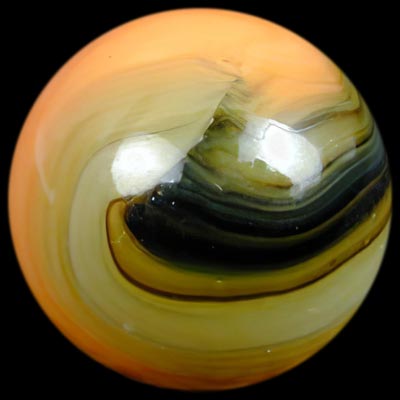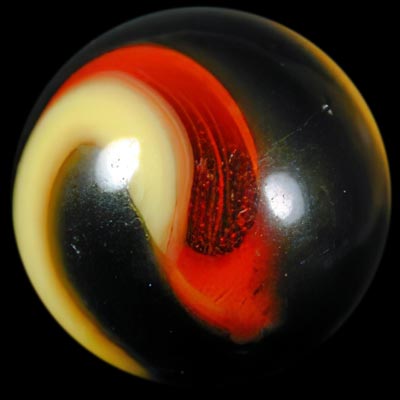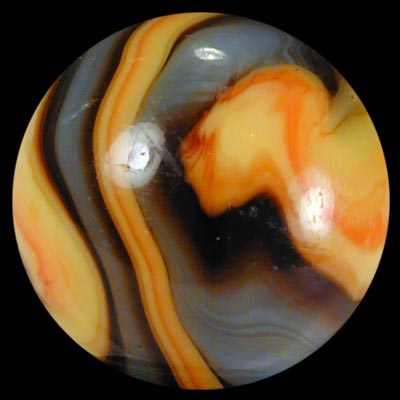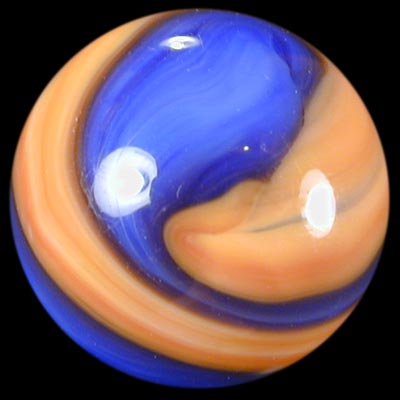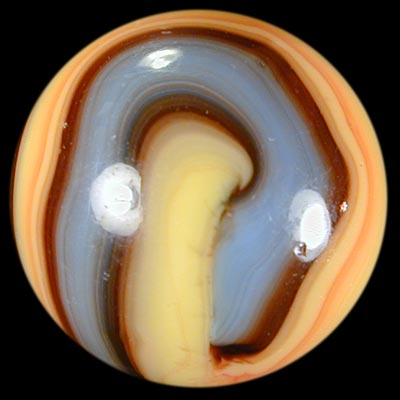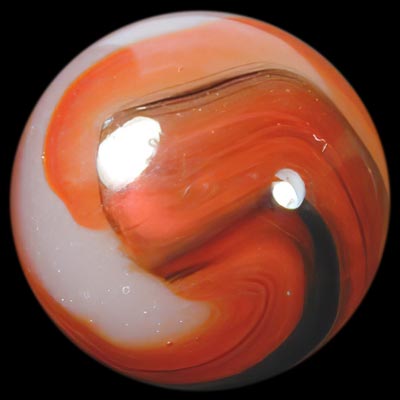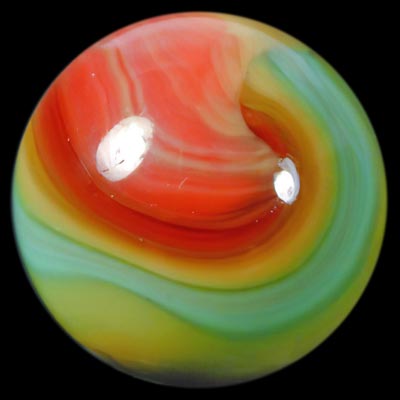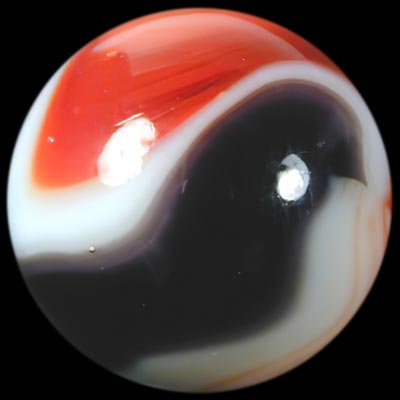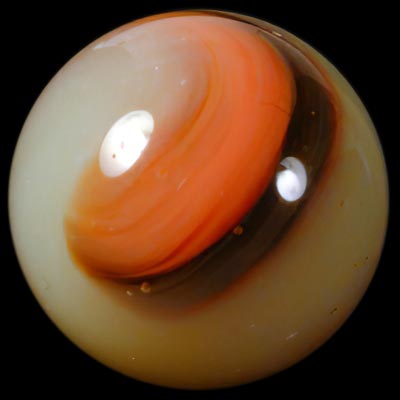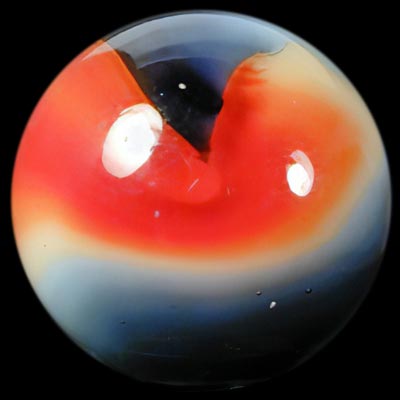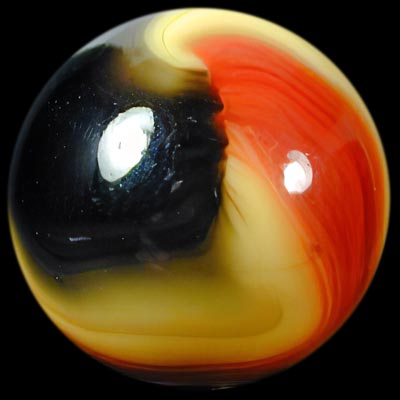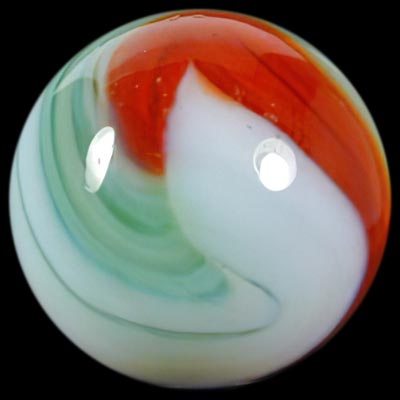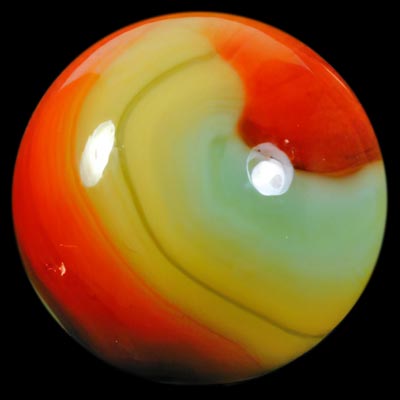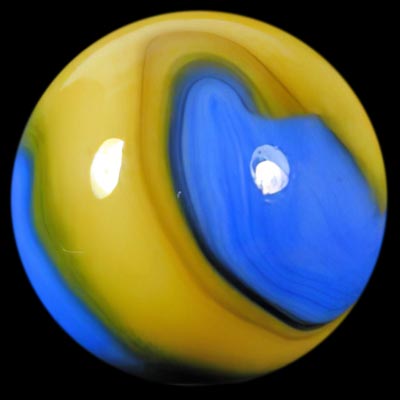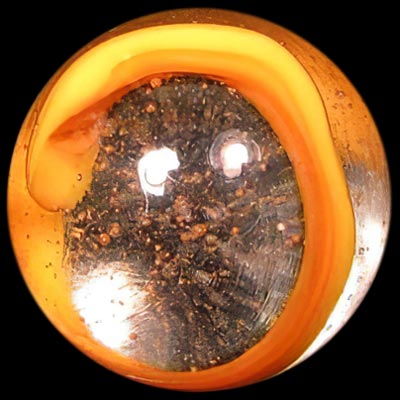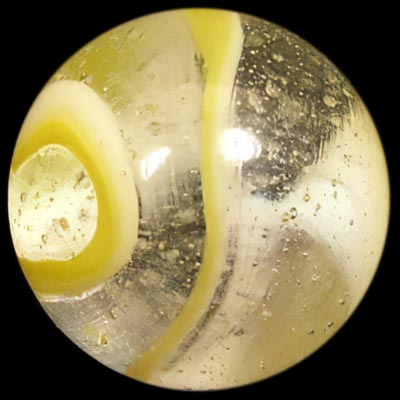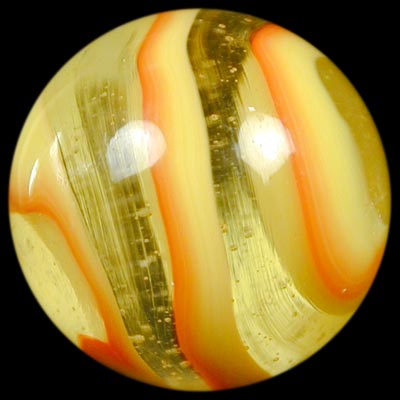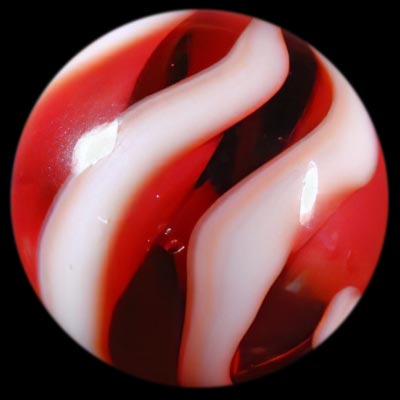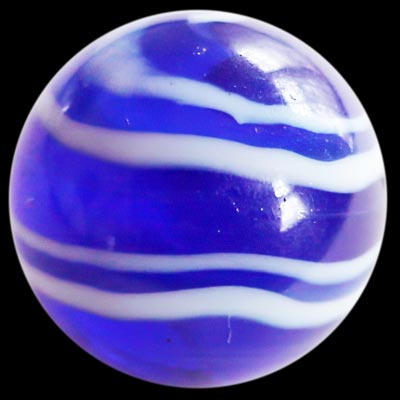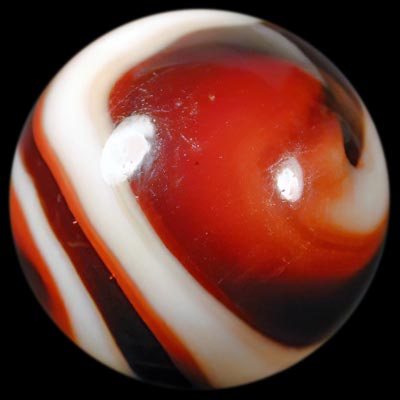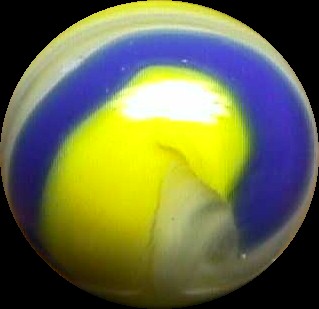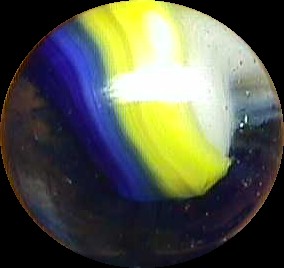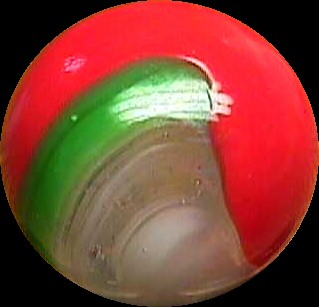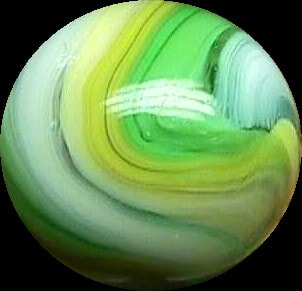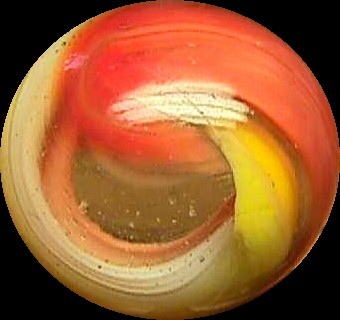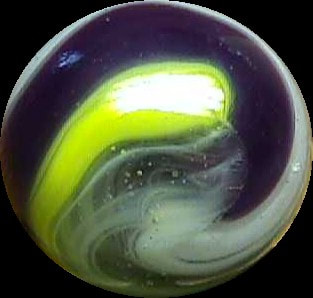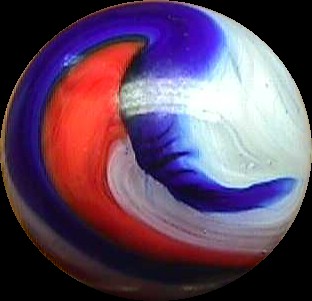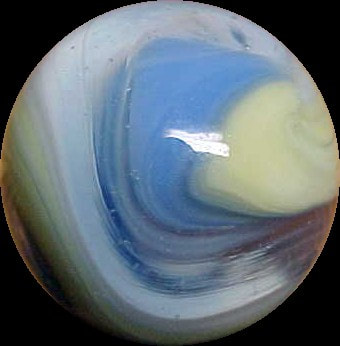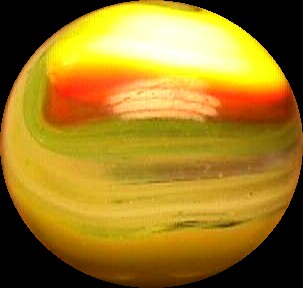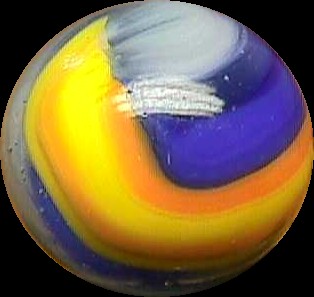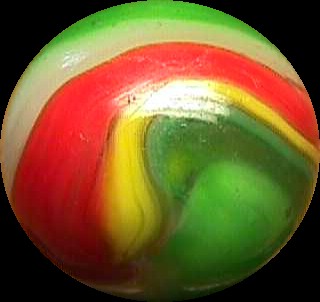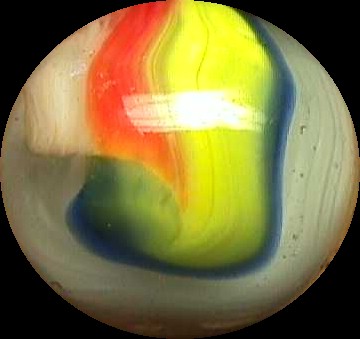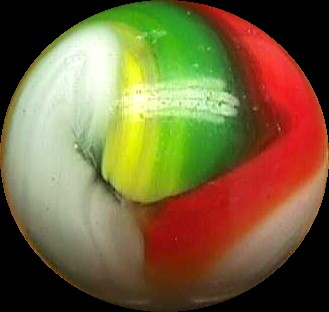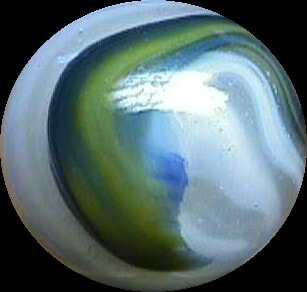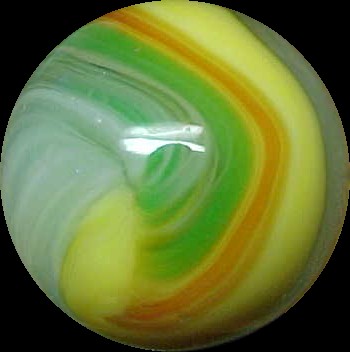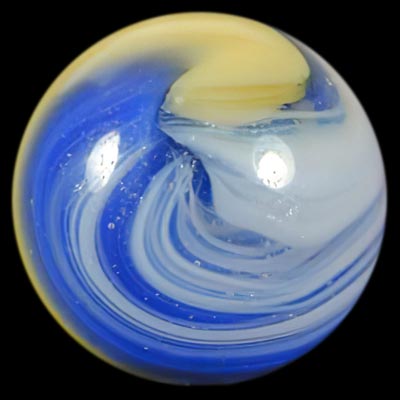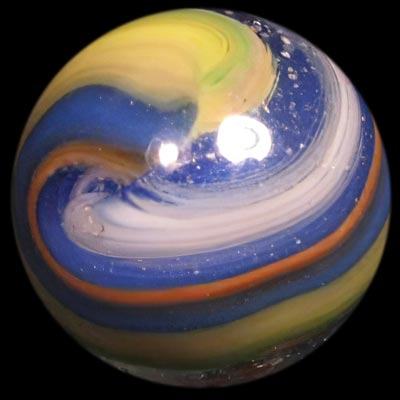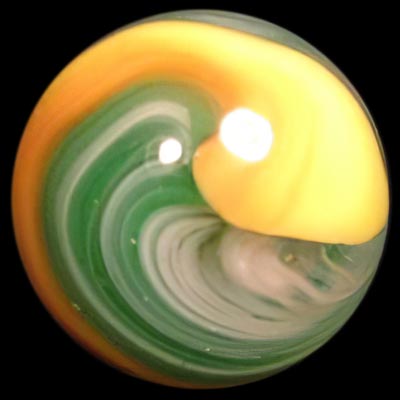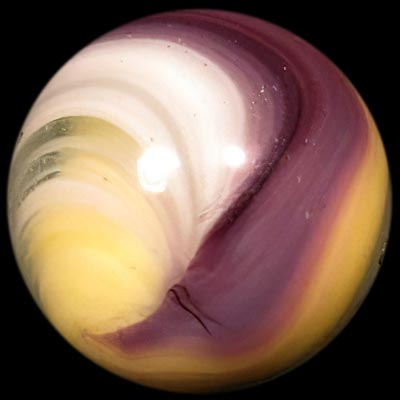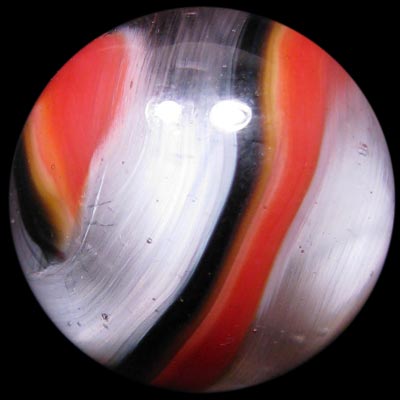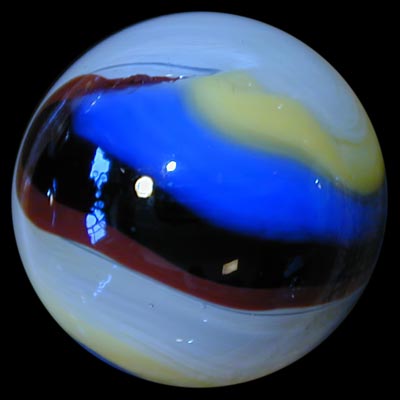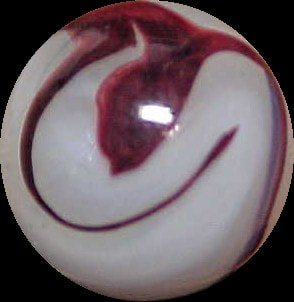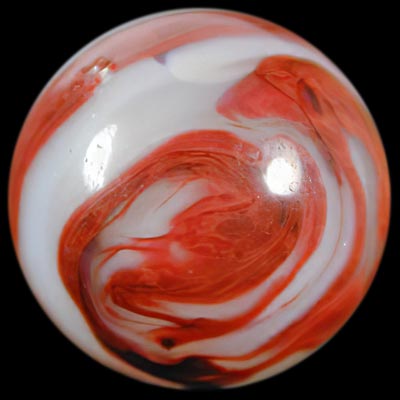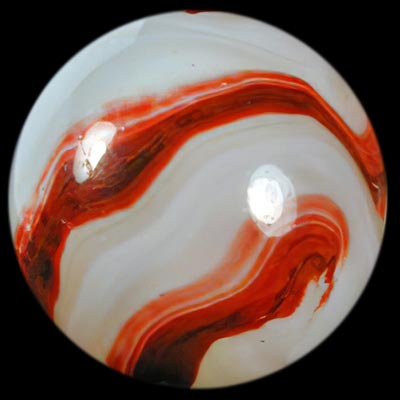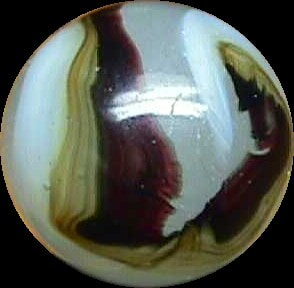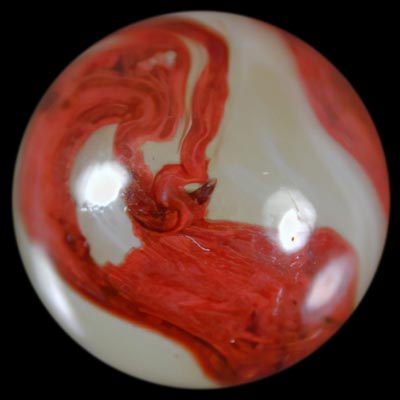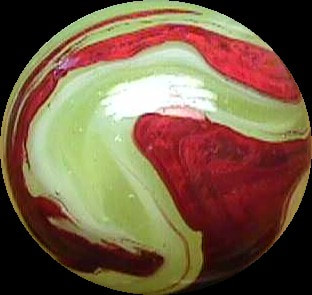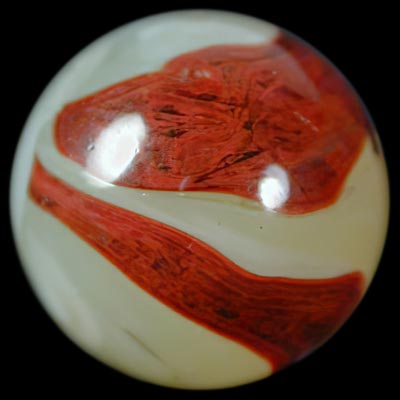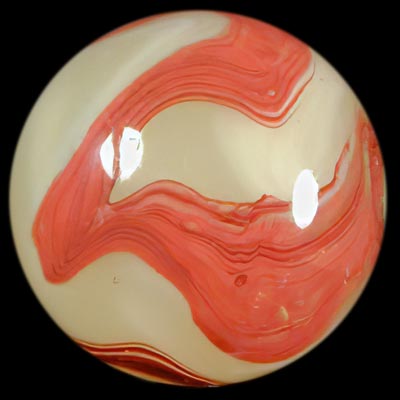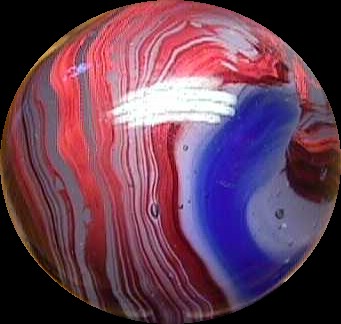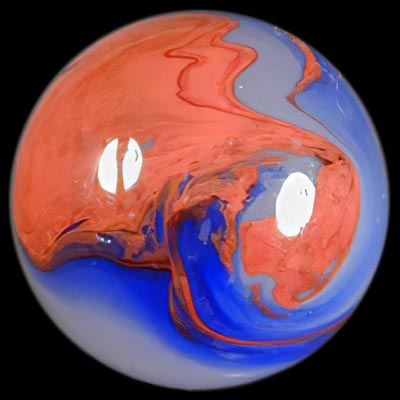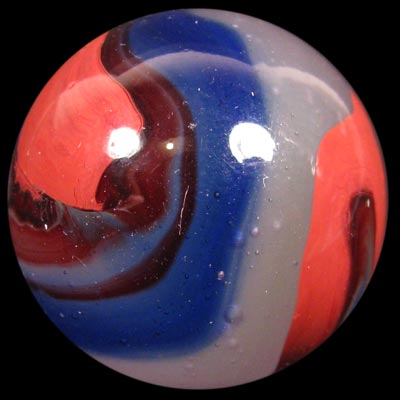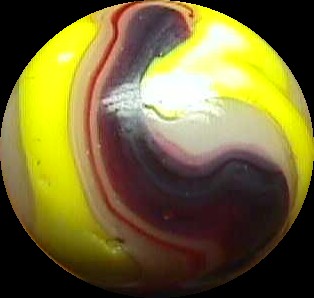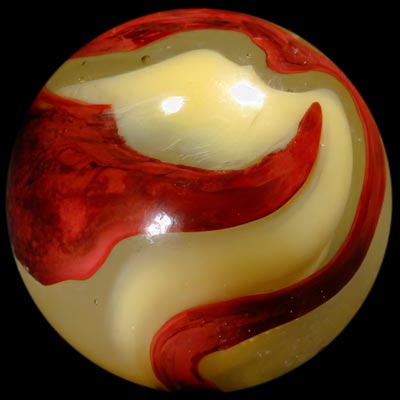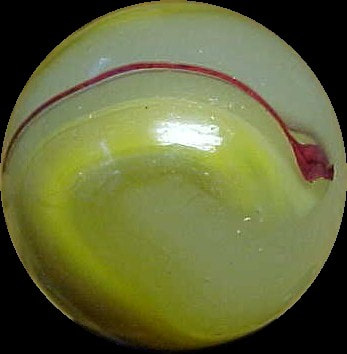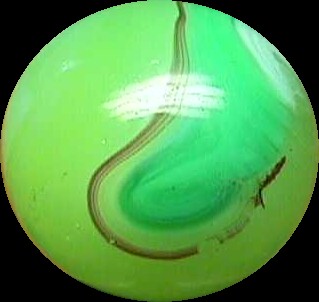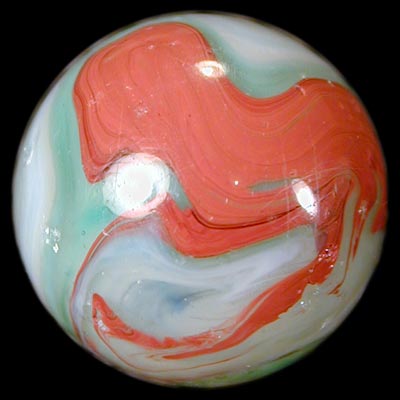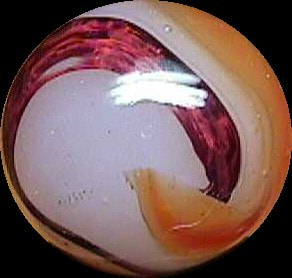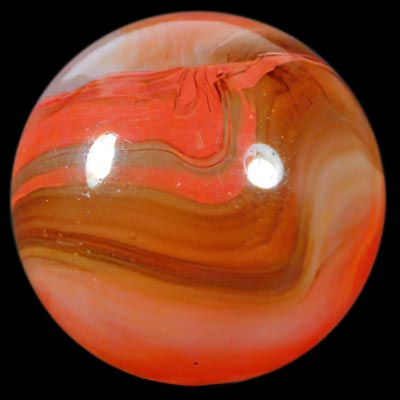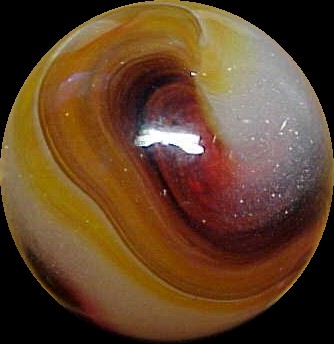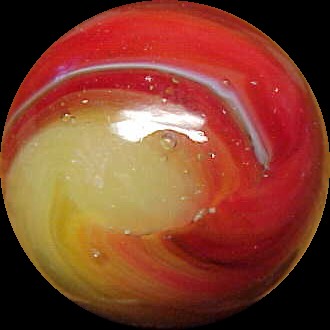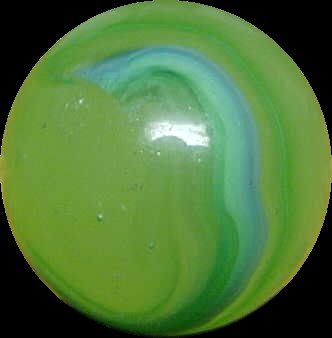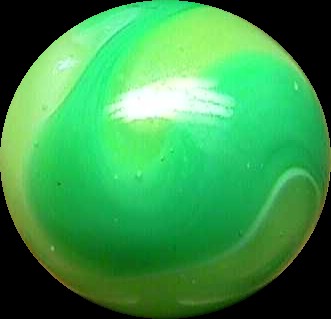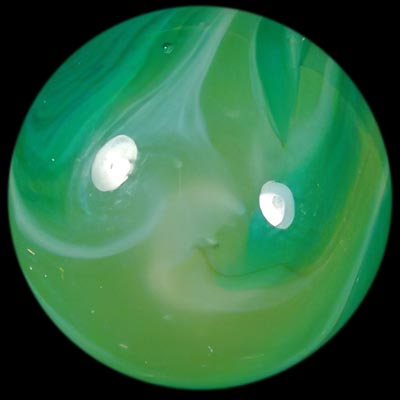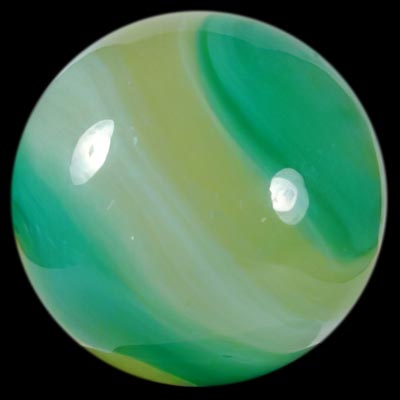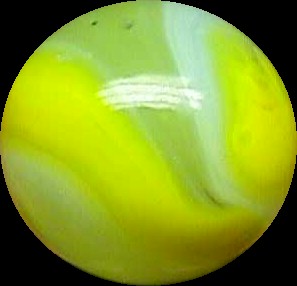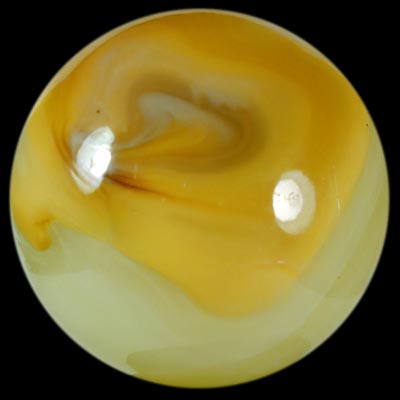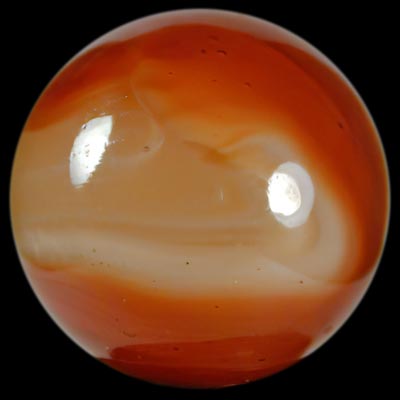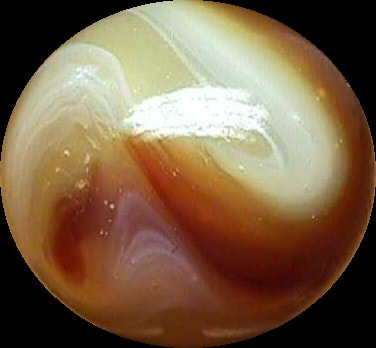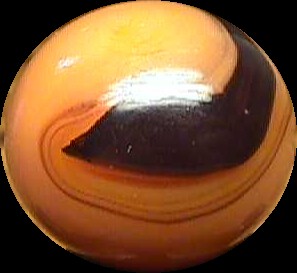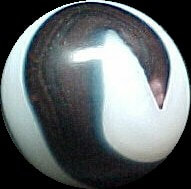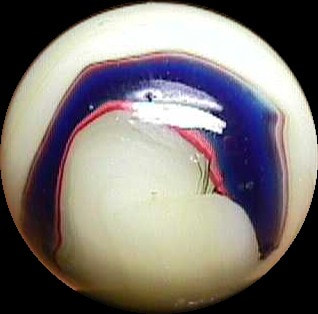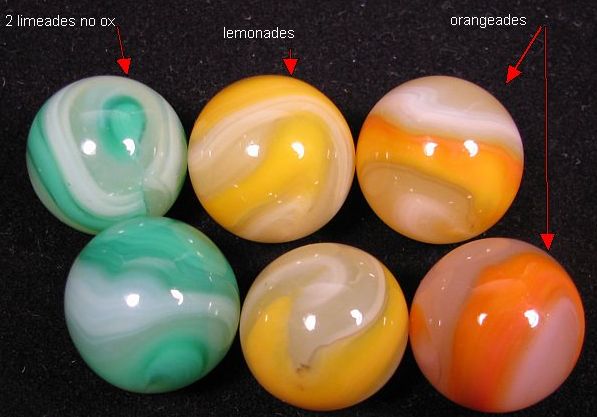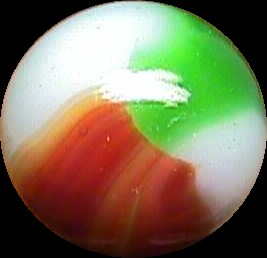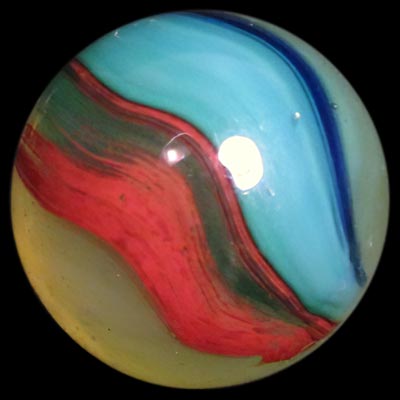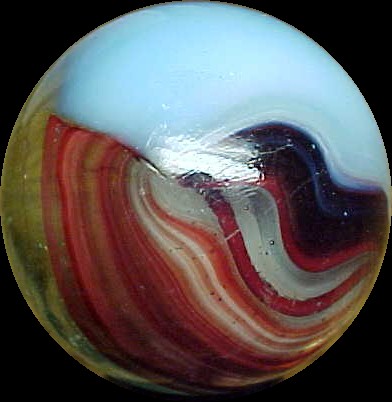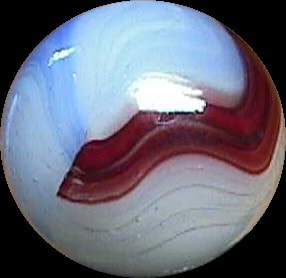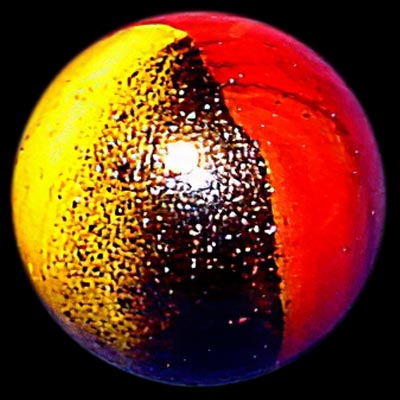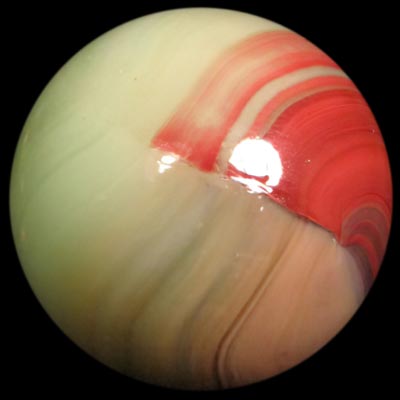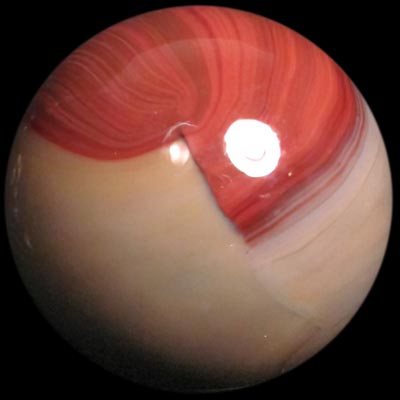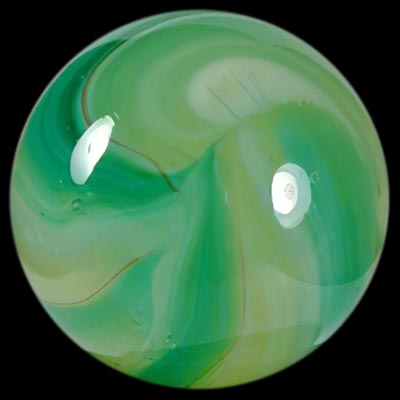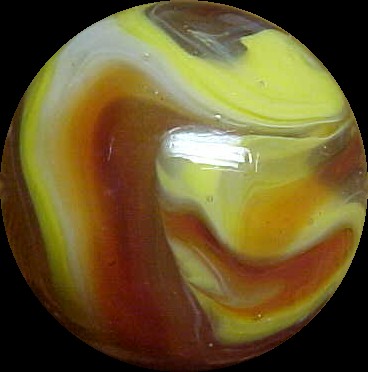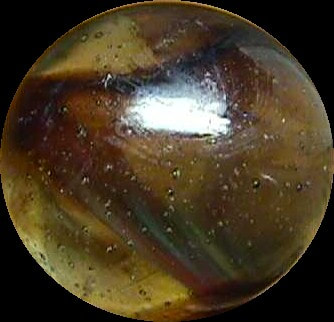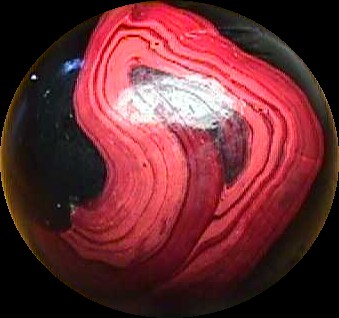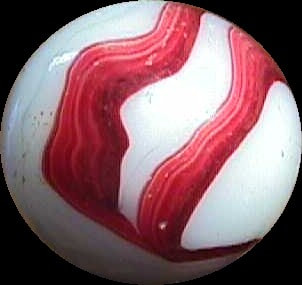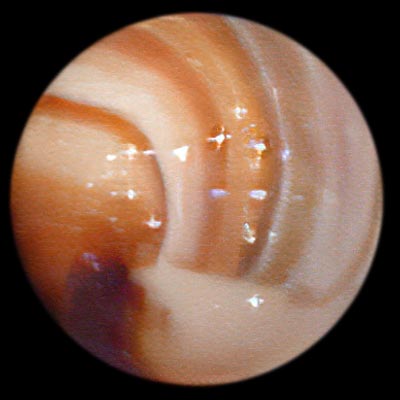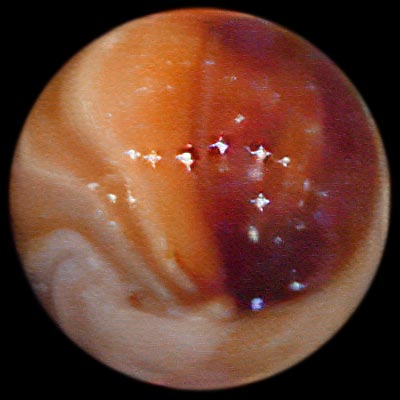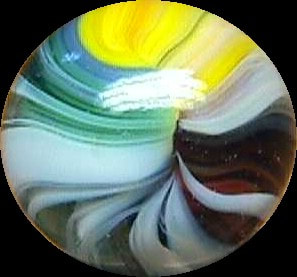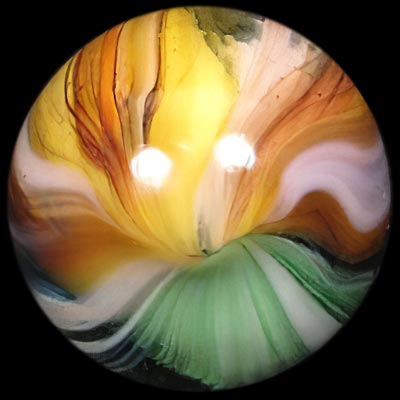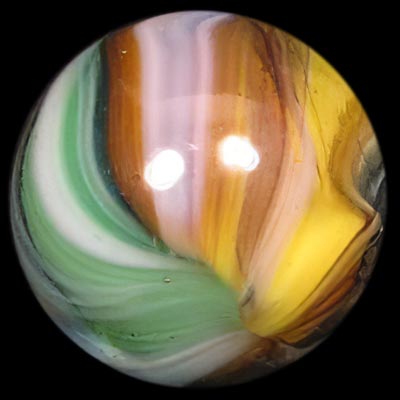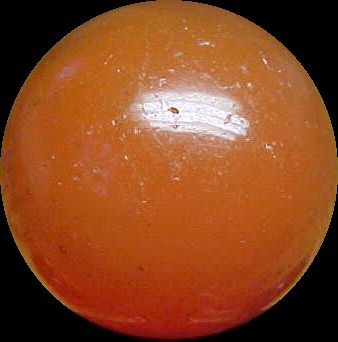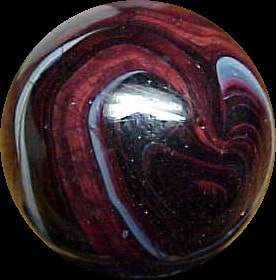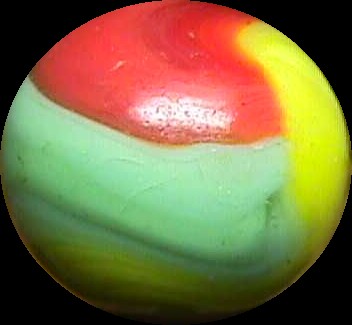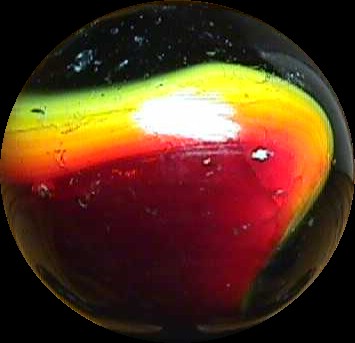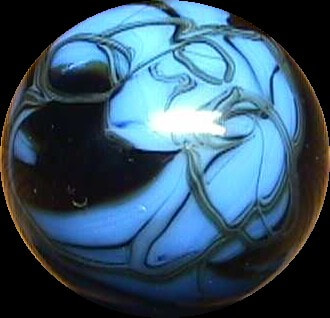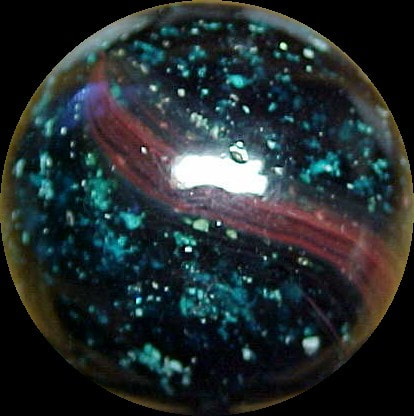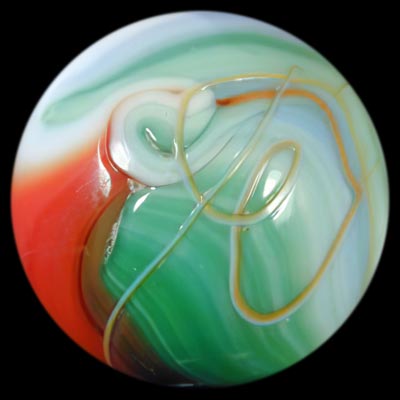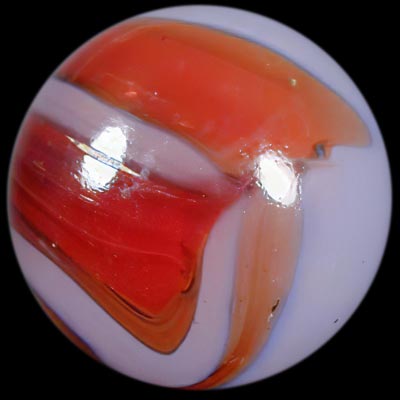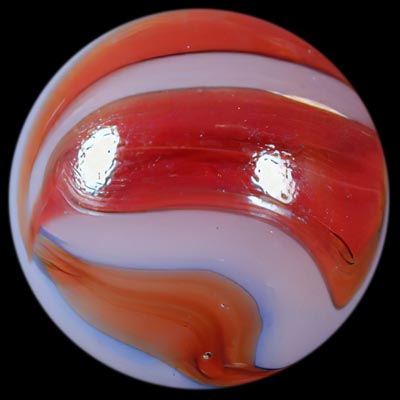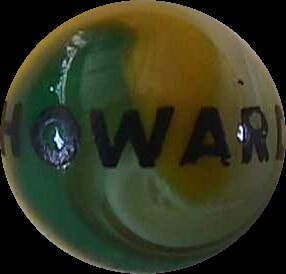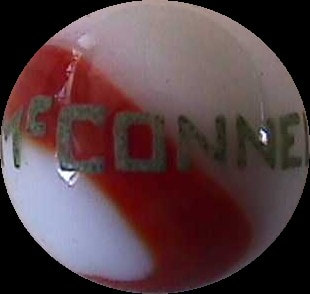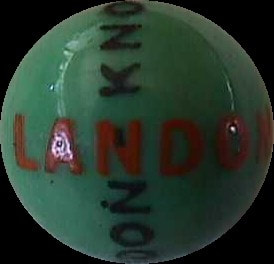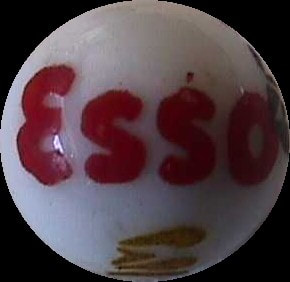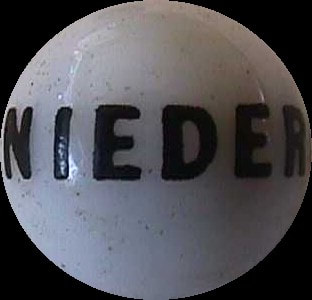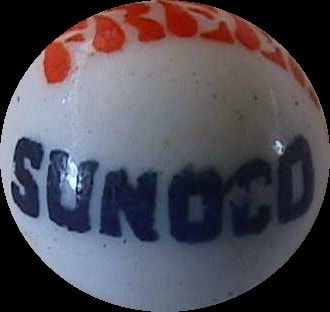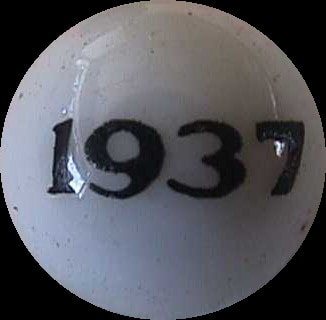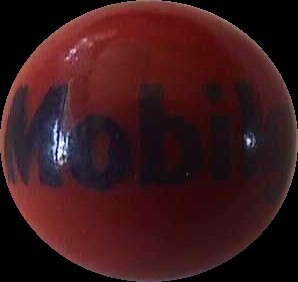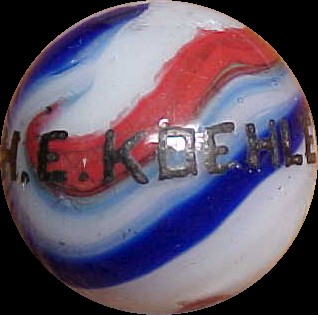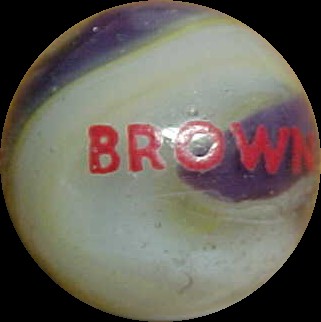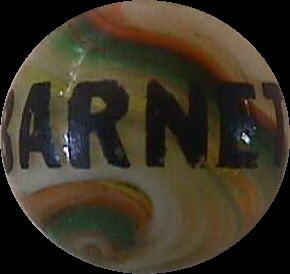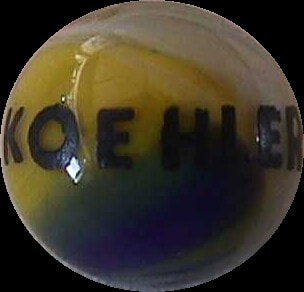AKRO AGATE COmpany (1910-1951)
COMPANY HISTORY
The Akro Agate Company, perhaps the best known of the marble manufacturers and certainly the most prolific during most of their career, was formed in 1910 in Akron, Ohio, by George T. Rankin and Gilbert C. Marsh. They used as their trademark, which was registered the following year, a crow holding marbles in its feet and beak and flying through a capital "A." For the first three years of the company's existence they simply bought and repackaged marbles made by M.F. Christensen and Son Company. In fact, their shop was located not too far away from the Christensen factory.
Meanwhile, M.F. Christensen's bookkeeper, Horace C. Hill, was embezzling money from his employer. Hill left the company in 1913 and joined up with Rankin and Marsh. In 1914, Hill moved the company to Clarksburg, West Virginia. Hill had applied for a patent on a marble-making machine in 1912 but it was at first rejected for being to similar to Martin Christensen's machine; perhaps Hill had stolen more than money from his employer. In 1915, a year following Akro Agate's relocation, and the same year in which Hill submitted a slightly different patent which was approved by the patent office, M.F. Christensen presented the courts with evidence of Hill's embezzlement. Hill paid back the $4,000 he had stolen, and died in early 1916, not too long after the death of Martin Christensen.
Akro Agate began marble production late in 1914. After Hill's demise, the company hired John F. Early, who made major improvements to Hill's machines. A major enhancement, the so-called Freese Improvement, was made in 1924 which allowed for more precision in the rounding of marbles and which did away with the tiny seams found at the poles of the marbles (often manifested on Corkscrews as fine feathering at or near the ends of the spiral). Previous to this as many as 20% of their marbles had to be rejected. A second improvement four years later more than doubled the production capacity of Akro's machines. The patent for this was approved in 1932, but by this time Early had left Akro Agate.
During the 1920s Akro Agate grew into the leading manufacturer of marbles thanks in large part to Early's innovations. Also, Arnold Fiedler, who had supplied Christensen Agate with its unique marble colors, worked for Akro Agate following his departure from Christensen (by some accounts prior to his employment with them), brought to the company his skills in glass mixing, which lent to Akro's marbles beautiful and vibrant eye appeal.
The 1930s saw some troubles for Akro Agate, as some of their key employees resigned at the beginning of the decade. Some of these went on the form the Master Marble Company. Sales of marbles declined everywhere toward the latter years of the decade and slowed even more in the subsequent decade. Akro began producing other glass objects during this period, including ashtrays, powder jars, jardinieres, vases, decorative flower pots, candlesticks, bowls, dishes, and more. These met with moderate success. Their line of colorful children's dishes did not sell well at first, but with the onset of America's involvement in World War II and the concomitant halt of imported Japanese toys they soon became more popular. However, this diversification did not pull Akro Agate from its decline, and by 1951 it closed down for good.
The Akro Agate factory site as it exists today covers some two acres. Late in 1997 and into early 1998 one of the buildings was demolished, revealing large numbers of discarded marbles beneath the foundation. Many experimental types, which were rejected by the company, were discovered due to this incident. This find was termed the "Old Annex" site. Toward the end of 1998 and additional discovery was made in the drainage system used by the factory. Dubbed the "French Drain" site, it yielded multitudes of marbles, again many of them experimental varieties that did not "make the grade." Several new oxblood marble types have entered the market as a consequence of the frantic digging that took place here.
The Akro Agate Company, perhaps the best known of the marble manufacturers and certainly the most prolific during most of their career, was formed in 1910 in Akron, Ohio, by George T. Rankin and Gilbert C. Marsh. They used as their trademark, which was registered the following year, a crow holding marbles in its feet and beak and flying through a capital "A." For the first three years of the company's existence they simply bought and repackaged marbles made by M.F. Christensen and Son Company. In fact, their shop was located not too far away from the Christensen factory.
Meanwhile, M.F. Christensen's bookkeeper, Horace C. Hill, was embezzling money from his employer. Hill left the company in 1913 and joined up with Rankin and Marsh. In 1914, Hill moved the company to Clarksburg, West Virginia. Hill had applied for a patent on a marble-making machine in 1912 but it was at first rejected for being to similar to Martin Christensen's machine; perhaps Hill had stolen more than money from his employer. In 1915, a year following Akro Agate's relocation, and the same year in which Hill submitted a slightly different patent which was approved by the patent office, M.F. Christensen presented the courts with evidence of Hill's embezzlement. Hill paid back the $4,000 he had stolen, and died in early 1916, not too long after the death of Martin Christensen.
Akro Agate began marble production late in 1914. After Hill's demise, the company hired John F. Early, who made major improvements to Hill's machines. A major enhancement, the so-called Freese Improvement, was made in 1924 which allowed for more precision in the rounding of marbles and which did away with the tiny seams found at the poles of the marbles (often manifested on Corkscrews as fine feathering at or near the ends of the spiral). Previous to this as many as 20% of their marbles had to be rejected. A second improvement four years later more than doubled the production capacity of Akro's machines. The patent for this was approved in 1932, but by this time Early had left Akro Agate.
During the 1920s Akro Agate grew into the leading manufacturer of marbles thanks in large part to Early's innovations. Also, Arnold Fiedler, who had supplied Christensen Agate with its unique marble colors, worked for Akro Agate following his departure from Christensen (by some accounts prior to his employment with them), brought to the company his skills in glass mixing, which lent to Akro's marbles beautiful and vibrant eye appeal.
The 1930s saw some troubles for Akro Agate, as some of their key employees resigned at the beginning of the decade. Some of these went on the form the Master Marble Company. Sales of marbles declined everywhere toward the latter years of the decade and slowed even more in the subsequent decade. Akro began producing other glass objects during this period, including ashtrays, powder jars, jardinieres, vases, decorative flower pots, candlesticks, bowls, dishes, and more. These met with moderate success. Their line of colorful children's dishes did not sell well at first, but with the onset of America's involvement in World War II and the concomitant halt of imported Japanese toys they soon became more popular. However, this diversification did not pull Akro Agate from its decline, and by 1951 it closed down for good.
The Akro Agate factory site as it exists today covers some two acres. Late in 1997 and into early 1998 one of the buildings was demolished, revealing large numbers of discarded marbles beneath the foundation. Many experimental types, which were rejected by the company, were discovered due to this incident. This find was termed the "Old Annex" site. Toward the end of 1998 and additional discovery was made in the drainage system used by the factory. Dubbed the "French Drain" site, it yielded multitudes of marbles, again many of them experimental varieties that did not "make the grade." Several new oxblood marble types have entered the market as a consequence of the frantic digging that took place here.
IDENTIFICATION TIPS
Akro Agate marbles were produced in a mind-boggling abundance and in a large variety of styles. Among the most common were the monochromatic "clearies" (transparent) and "Opals" (opaque) marbles. These are just about impossible to distinguish from the almost identical marbles from other companies, though if one pays close scrutiny to the opaque marbles in original Akro Agate Chinese Checkers boxes, subtle differences between their colors and those of other manufacturers can be observed. The company, however, is to collectors better known for its production of many varieties unique to them and therefore usually readily identifiable.
SLAGS
Akro Agate slags ("Striped Onyxes") were available in the following colors (in increasing order of rarity): amber, purple, blue, green, red, aqua, clear, vaseline, and orange. The red slags were called Cardinal Reds by the company. Like the slags of other companies, those of Akro were produced by the single-stream method and include a transparent colored based mixed with opaque white glass. One exception is the Cornelian which was produced in the same method as a slag but consists of an opaque red base mixed with opaque white. Perhaps the best way to identify an Akro Agate slag is not by any particular feature but rather by its lack of features. Akro Agate slags will lack the seams seen in Christensen Agate and Peltier examples, the fine feathering of the white seen in Peltier examples, and the "nine and tail" of the white as well as the cut-off mark of M.F. Christensen examples. As to the latter rule of thumb, it needs to be stated that early Akro slags, like those of M.F. Christensen and Christensen Agate, were hand-gathered and therefore may exhibit the "nine"-shaped pattern of the white where the marble was twisted out of the glass furnace.
Akro Agate marbles were produced in a mind-boggling abundance and in a large variety of styles. Among the most common were the monochromatic "clearies" (transparent) and "Opals" (opaque) marbles. These are just about impossible to distinguish from the almost identical marbles from other companies, though if one pays close scrutiny to the opaque marbles in original Akro Agate Chinese Checkers boxes, subtle differences between their colors and those of other manufacturers can be observed. The company, however, is to collectors better known for its production of many varieties unique to them and therefore usually readily identifiable.
SLAGS
Akro Agate slags ("Striped Onyxes") were available in the following colors (in increasing order of rarity): amber, purple, blue, green, red, aqua, clear, vaseline, and orange. The red slags were called Cardinal Reds by the company. Like the slags of other companies, those of Akro were produced by the single-stream method and include a transparent colored based mixed with opaque white glass. One exception is the Cornelian which was produced in the same method as a slag but consists of an opaque red base mixed with opaque white. Perhaps the best way to identify an Akro Agate slag is not by any particular feature but rather by its lack of features. Akro Agate slags will lack the seams seen in Christensen Agate and Peltier examples, the fine feathering of the white seen in Peltier examples, and the "nine and tail" of the white as well as the cut-off mark of M.F. Christensen examples. As to the latter rule of thumb, it needs to be stated that early Akro slags, like those of M.F. Christensen and Christensen Agate, were hand-gathered and therefore may exhibit the "nine"-shaped pattern of the white where the marble was twisted out of the glass furnace.
AKRO SLAGS GALLERY
(Hover your mouse or lightly touch the image to see the type of marble. Click to view the full size image)
(Hover your mouse or lightly touch the image to see the type of marble. Click to view the full size image)
CORKSCREWS
Perhaps the most popular Akro Agate marbles are the corkscrews. These are basically unique to the company and consist of one or more spirals of color encircling the marble from one pole to the other without ever crossing. Some corkscrews have a double or triple twist, particularly those in transparent glass. Corkscrews may have a white, colored, or transparent base; some contain several colors, fluorescent glass, or oxblood. The variety is nearly limitless, and is enhanced by hybrids and experimentals. Corkscrews come in a variety of sizes, though any over one inch are extremely rare and were usually "experimentals," whereas those 1/2" or smaller are perhaps even more scarce. Some corkscrews will possess feathering near the ends of the spirals, manifested as fine "fingers" of color extending from tiny crescent-shaped crimp marks; as mentioned earlier, this trait indicates manufacture prior to the "Freese improvement" of the mid-1920s. Such early marbles will also usually have vibrant colors.
Corkscrews with two opaque colors were called Prize Names, while those with three or more opaque colors were called Specials. Three color corkscrews were sold in stock boxes labeled 'Tri-Colors'. Corkscrews come in a bewildering array of color combinations. White-based examples are most common. Usually, the colors formed separate strata as they were injected into the shearing mechanisms of the marble machines. However, sometimes the colors blended, perhaps because the densities of the different colored glass were similar. When counting colors in corkscrews, it is generally accepted that the blended colors are not counted separately. Therefore, for instance, a blue and yellow corkscrew with a green blend is a two-color Prize Name, not a Tri-Color Special.
Other types of corkscrews named by the company itself include: Spirals, which have a transparent clear base and a colored spiral; Onyxes, which have a transparent colored base with a white spiral; and Aces, which have a translucent milky white base with a thin colored spiral. Some names have been adopted by collectors. A "snake" is a Spiral or Onyx with the spiral near the surface of the marble (most often in clear glass), while a "ribbon" has the spiral nearer to the center. Rarely, a corkscrew will be a cross between a Spiral and an Onyx, in that it will have a colored transparent base and a colored spiral. However, these are often misidentified, as a white spiral may simply look colored beneath the colored base glass.
Perhaps the most popular Akro Agate marbles are the corkscrews. These are basically unique to the company and consist of one or more spirals of color encircling the marble from one pole to the other without ever crossing. Some corkscrews have a double or triple twist, particularly those in transparent glass. Corkscrews may have a white, colored, or transparent base; some contain several colors, fluorescent glass, or oxblood. The variety is nearly limitless, and is enhanced by hybrids and experimentals. Corkscrews come in a variety of sizes, though any over one inch are extremely rare and were usually "experimentals," whereas those 1/2" or smaller are perhaps even more scarce. Some corkscrews will possess feathering near the ends of the spirals, manifested as fine "fingers" of color extending from tiny crescent-shaped crimp marks; as mentioned earlier, this trait indicates manufacture prior to the "Freese improvement" of the mid-1920s. Such early marbles will also usually have vibrant colors.
Corkscrews with two opaque colors were called Prize Names, while those with three or more opaque colors were called Specials. Three color corkscrews were sold in stock boxes labeled 'Tri-Colors'. Corkscrews come in a bewildering array of color combinations. White-based examples are most common. Usually, the colors formed separate strata as they were injected into the shearing mechanisms of the marble machines. However, sometimes the colors blended, perhaps because the densities of the different colored glass were similar. When counting colors in corkscrews, it is generally accepted that the blended colors are not counted separately. Therefore, for instance, a blue and yellow corkscrew with a green blend is a two-color Prize Name, not a Tri-Color Special.
Other types of corkscrews named by the company itself include: Spirals, which have a transparent clear base and a colored spiral; Onyxes, which have a transparent colored base with a white spiral; and Aces, which have a translucent milky white base with a thin colored spiral. Some names have been adopted by collectors. A "snake" is a Spiral or Onyx with the spiral near the surface of the marble (most often in clear glass), while a "ribbon" has the spiral nearer to the center. Rarely, a corkscrew will be a cross between a Spiral and an Onyx, in that it will have a colored transparent base and a colored spiral. However, these are often misidentified, as a white spiral may simply look colored beneath the colored base glass.
AKRO CORKSCREWS GALLERY
(Hover your mouse or lightly touch the image to see the type of marble. Click to view the full size image)
(Hover your mouse or lightly touch the image to see the type of marble. Click to view the full size image)
One of the most popular corkscrew types is the Popeye (marketed as the Tri-Onyx by the company), so-named because it was sold in the much-sought after Popeye box (which depicted the cartoon character). This marble is recognizable because it contains a transparent clear glass with opaque white filaments in addition to a combination of two other colors (Popeyes with three or more colors are called Hybrid Popeyes). Some Popeyes have very little clear areas in them, while others have wide clear areas. Popeye color combinations, in approximate decreasing order of frequency, include red/yellow, green/yellow, red/green, dark blue/yellow, light purple/yellow, dark purple/yellow, powder blue/yellow, dark blue/red, red/orange, blue/green, and black/yellow. The yellow is often entirely or, more often, partially fluorescent.
Related to Popeyes are Imperials and Ringers. Ringers have the clear areas with white filaments of Popeyes but only have one additional color. Usually this color is transparent red or orange. Imperials have a more translucent milky base, with a red spiral shadowed by a more transparent orange spiral.
Related to Popeyes are Imperials and Ringers. Ringers have the clear areas with white filaments of Popeyes but only have one additional color. Usually this color is transparent red or orange. Imperials have a more translucent milky base, with a red spiral shadowed by a more transparent orange spiral.
AKRO POPEYES, IMPERIALS & RINGERS GALLERY
(Hover your mouse or lightly touch the image to see the type of marble. Click to view the full size image)
(Hover your mouse or lightly touch the image to see the type of marble. Click to view the full size image)
"Ade" corkscrews are identified by their base glass of translucent off-white mixed with wispy opaque white. The spirals on these marbles will be translucent and come in yellow ("lemonades"), green ("limeades"), orange ("orangeades"), red ("cherryades"), and reddish brown (Carnelians). Sometimes these spirals will be accompanied by oxblood, though this is a more common feature on Ade swirls (see below). Lemonade oxbloods and limeade oxbloods are most common; typically, there is more oxblood on the former than the latter.
Besides oxblood ades, oxblood may occur on other corkscrews. Oxblood is a type of glass that is always dark opaque red with fine black filaments in it. It is extremely easy to recognize once a collector has seen it at least once. Oxblood corkscrews can be quite valuable. One of the rarest types, if not the rarest, is the Popeye oxblood. Besides this and the aforementioned oxblood ades, oxblood corkscrews can include oxblood on a transparent clear base ("clear oxbloods"), oxblood on a translucent milky white base ("Milky Oxbloods"), oxblood on translucent wispy white base ("silver oxbloods"), oxblood on an opaque brown base ("chocolate oxbloods"), oxblood on a milky translucent white base with opaque yellow ("eggyolk oxbloods"), and oxblood on a milky translucent white base with translucent blue ("blue oxbloods"). These are more commonly seen as swirls than as corkscrews, though.
True oxblood corkscrews are usually on an opaque or translucent white base, though oxblood on colored bases are known but are rare. Oxblood on top of a blue spiral on a white base is known as a "blueblood." Hybrid examples (e.g. "blue eggyolk oxbloods") occur but are extremely rare. It should be emphasized that oxblood usually occurs on the surface of a marble but is sometimes found beneath.
Sometimes two corkscrews fell down the marble machine chute at the same time, forming together into what is called a "double ingot" corkscrew. This usually is found with those that have all opaque colors and which are in shooter sizes. The resulting marble has what appears to be seams and a "broken" corkscrew pattern. These are frequently mistaken for Peltier's National Line Rainbos.
Besides oxblood ades, oxblood may occur on other corkscrews. Oxblood is a type of glass that is always dark opaque red with fine black filaments in it. It is extremely easy to recognize once a collector has seen it at least once. Oxblood corkscrews can be quite valuable. One of the rarest types, if not the rarest, is the Popeye oxblood. Besides this and the aforementioned oxblood ades, oxblood corkscrews can include oxblood on a transparent clear base ("clear oxbloods"), oxblood on a translucent milky white base ("Milky Oxbloods"), oxblood on translucent wispy white base ("silver oxbloods"), oxblood on an opaque brown base ("chocolate oxbloods"), oxblood on a milky translucent white base with opaque yellow ("eggyolk oxbloods"), and oxblood on a milky translucent white base with translucent blue ("blue oxbloods"). These are more commonly seen as swirls than as corkscrews, though.
True oxblood corkscrews are usually on an opaque or translucent white base, though oxblood on colored bases are known but are rare. Oxblood on top of a blue spiral on a white base is known as a "blueblood." Hybrid examples (e.g. "blue eggyolk oxbloods") occur but are extremely rare. It should be emphasized that oxblood usually occurs on the surface of a marble but is sometimes found beneath.
Sometimes two corkscrews fell down the marble machine chute at the same time, forming together into what is called a "double ingot" corkscrew. This usually is found with those that have all opaque colors and which are in shooter sizes. The resulting marble has what appears to be seams and a "broken" corkscrew pattern. These are frequently mistaken for Peltier's National Line Rainbos.
AKRO OXBLOODS & ADES GALLERY
(Hover your mouse or lightly touch the image to see the type of marble. Click to view the full size image)
(Hover your mouse or lightly touch the image to see the type of marble. Click to view the full size image)


